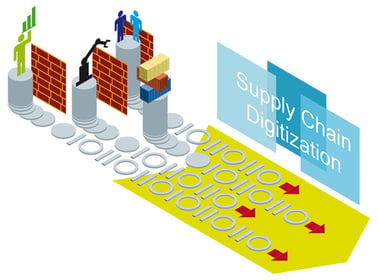6 Supply Chain Digitization Stats to Know
Brian Hoey - November 08, 2018

 We tend to think of the (first) industrial revolution as a moment where the world changed in the blink of an eye. One morning, the world was dominated by cottage industries, and the next, steam power had completely transformed the nature of commerce, manufacturing, and modern life. What we sometimes forget is that the period we think of as the industrial revolution actually lasted more than 60 years—more than the length of a human life span during that era. Sure, things move a lot more quickly now, but it’s still a nice reminder that for all the talk about Industry 4.0 (aka the fourth industrial revolution), nothing happens overnight. The process of factories getting more connected and supply chains going digital might not take 60 years, but in the meantime it still remains a work in progress. That said, it's increasingly likely that the rewards will be worth the challenges.
We tend to think of the (first) industrial revolution as a moment where the world changed in the blink of an eye. One morning, the world was dominated by cottage industries, and the next, steam power had completely transformed the nature of commerce, manufacturing, and modern life. What we sometimes forget is that the period we think of as the industrial revolution actually lasted more than 60 years—more than the length of a human life span during that era. Sure, things move a lot more quickly now, but it’s still a nice reminder that for all the talk about Industry 4.0 (aka the fourth industrial revolution), nothing happens overnight. The process of factories getting more connected and supply chains going digital might not take 60 years, but in the meantime it still remains a work in progress. That said, it's increasingly likely that the rewards will be worth the challenges.
91%
The proportion of German manufacturers who are investing in digitization. Only 6%, however, describe themselves as fully digitized. Just as we were saying in the introduction, the task of digitization in factories and throughout the supply is still ongoing. This number should give you a sense of how confident manufacturers are in the power of digitization (very), compared to how difficult it can be to put that confidence into practice. On the one hand, digital supply chains promise to provide never-before-seen visibility into real-time processes, creating environments in which advanced analytics workflows can thrive and planning hurdles like low forecast quality and opaque resource data can be overcome. On the other, there are a number of hurdles that stand in the way of successful digitization. What are they, you ask? Read on to find out.
3 out of 10
The number of large companies that cite organizational structure as a top hurdle to digitization. More than a quarter of the largest survey respondents (those grossing over $1 billion annually) also cited inflexible business practices or an unwillingness to experiment as key hurdles to creating a robust digital infrastructure. What does this mean, exactly? Simply put, large manufacturing outfits often lack the agility and cohesion to undertake large scale changes in the way the supply chain is administered. Even if the will to update IT infrastructure and processes exists, data and decision-making silos and shadow IT make it difficult to choose, implement, and connect the kinds of digital solutions that power Industry 4.0 workflows (like digitally mapping your factory floor onto a “digital twin” or utilizing IoT devices to sense the need for machine maintenance). The result is that even the digital processes that do come into being don’t connect and interact in a way that adds value.
More than half
The amount data housed by businesses that’s considered “dark data.” According to one survey, at least. At this point you might be asking yourself, “what is dark data, and why should I care about it?” Dark data is essentially data that’s been collected and stored, but whose contents are not being analyzed or utilized in any way. For digital factories and digital supply chains, dark data is simply a fact of life—owing to the proliferation of IoT devices, sensors, RFID chips, and the like. But the fact that the number is so high suggests that, at least, in the current state of affairs, most data is not being used to its maximum advantage. This means that, by and large, even where some supply chain digitization has taken place, there’s still a lack of cohesion cross-functionally, which supply chain managers can only deal with by continuing to break down silos, update legacy IT systems, and avoid shadow IT.
50%
The potential improvement in production rates due to real-time data integration. So far, our facts have really dwelled on the hurdles that face modern manufacturers trying to enter the digital age. But don’t get discouraged! The rest of the list will feature a healthy measure of optimism. To wit, McKinsey found that one representative manufacturing outfit, by integrating real-time data visualizations into a particular production line, was able to more rapidly and more effectively identify data or behaviors associated with failures, slowdowns, and bottlenecks. Because they were able to spot these indicators in the middle of production, they were also able to make rapid, proactive responses and continual process improvements. The end result was a 50% increase in daily production rates that would have been virtually impossible in a non-digital environment.
10 employees, 2 hours
The amount of time and person-power it now takes for an individual Zara retailer to update its inventory, compared to 40 employees working for 5 hours in the past. How did they decrease their resource needs for inventory tracking so dramatically? Essentially, they were able to attach RFID tags to every item of clothing within many of their stores, meaning that inventory processes that used to require lots of manual counting of goods could instead be partially automated. Though Zara might seem like an odd company to name drop on a blog aimed largely at auto manufacturers, shippers, and freight forwarders, their extremely short product lead times mean that their supply chain requirements are actually extremely stringent. As such, their success in streamlining the inventory process gives an indication of how powerful digitized workflows can be at various touchpoints on the value chain.
$5.2 billion
The estimated global market for 3D printing by 2020. This, too, should give you an idea how much room for growth there is in the digital supply chain, especially because 3D printing in many ways represents the apex of digitization. It requires that the entire design and production process take place in a digital environment, and it rewards the integration of other digitized workflows (in a factory that’s already digitized, for instance, a 3D printer could much more easily produce a custom-part to repair a particular piece of machinery if that machine already has a digital copy), but the result for manufacturers can be process cost reductions of as much as 50%. Not only can this technology afford companies the resources for rapid prototyping and small batch production runs, it's increasingly helping to pave the way for a new level of product customization. Thus, instead of being unable to provide customers with goods that meet their exact specifications on a granular level, modern manufacturers are suddenly able to provide more value than ever before, thanks to this highly digitized workflow.
LATEST POSTS
- Understand Circular Economy in The Manufacturing Industry
- How Can Industry 4.0 IT Integration Be Achieved Smoothly?
- The Significance of Order Sequencing in Discrete Manufacturing
- How to improve your Supply Chain Management: The Power of Control Towers
- Optimizing Human Resource Scheduling in Manufacturing: A Technological Approach



